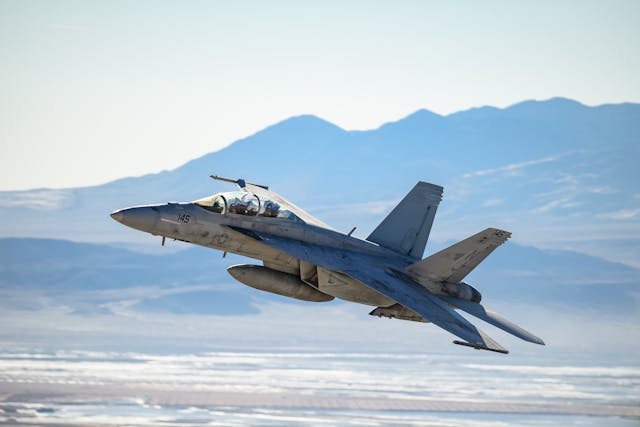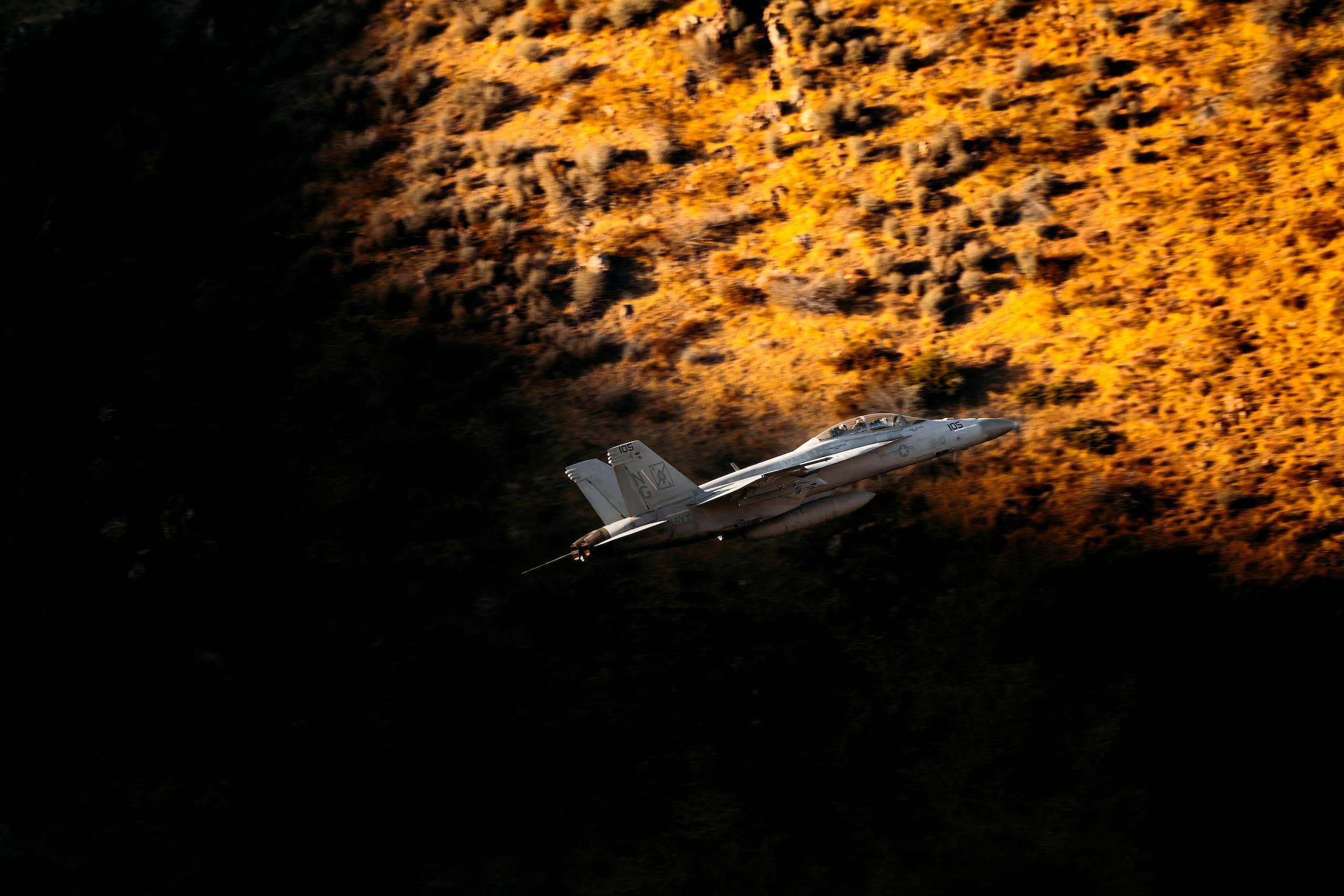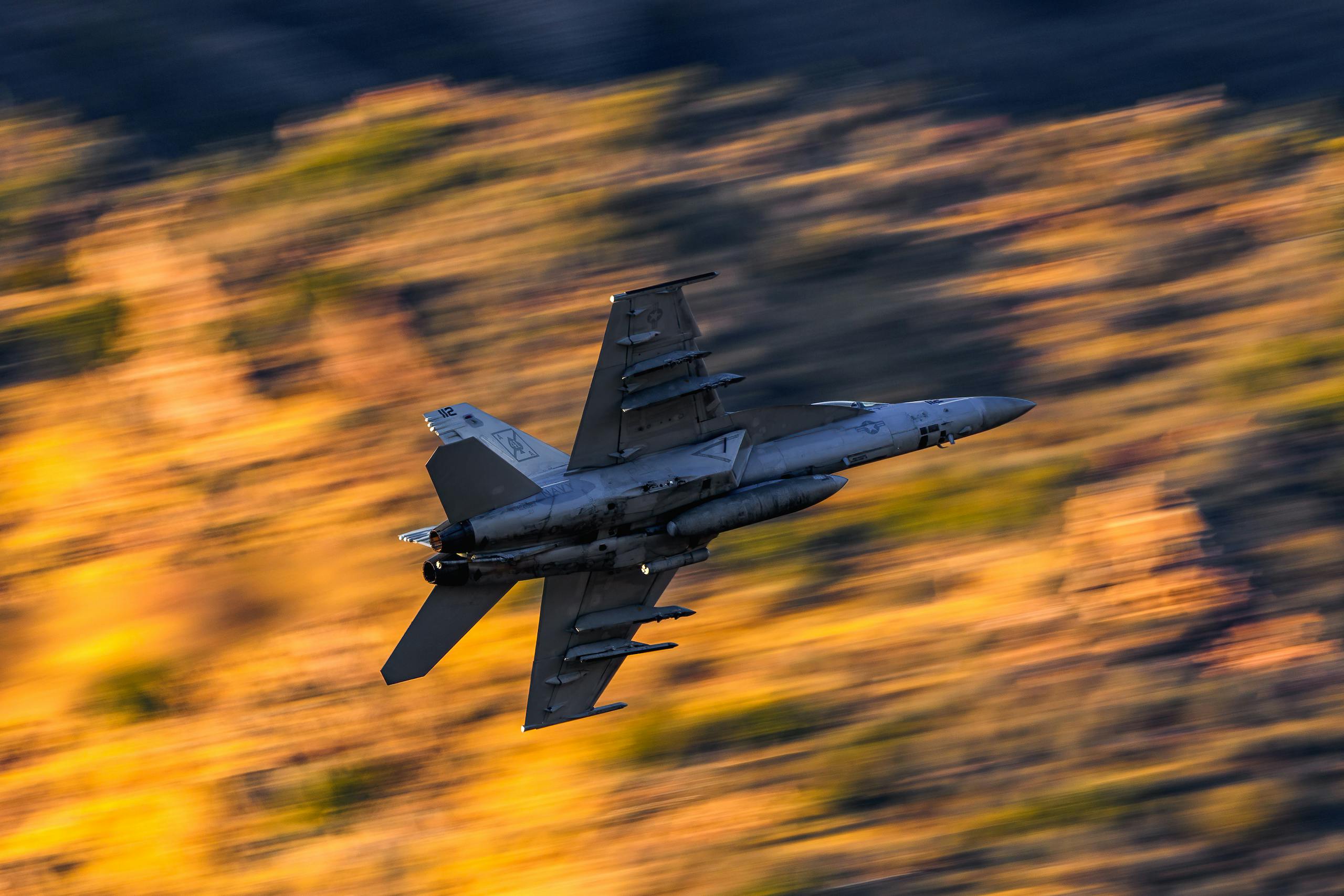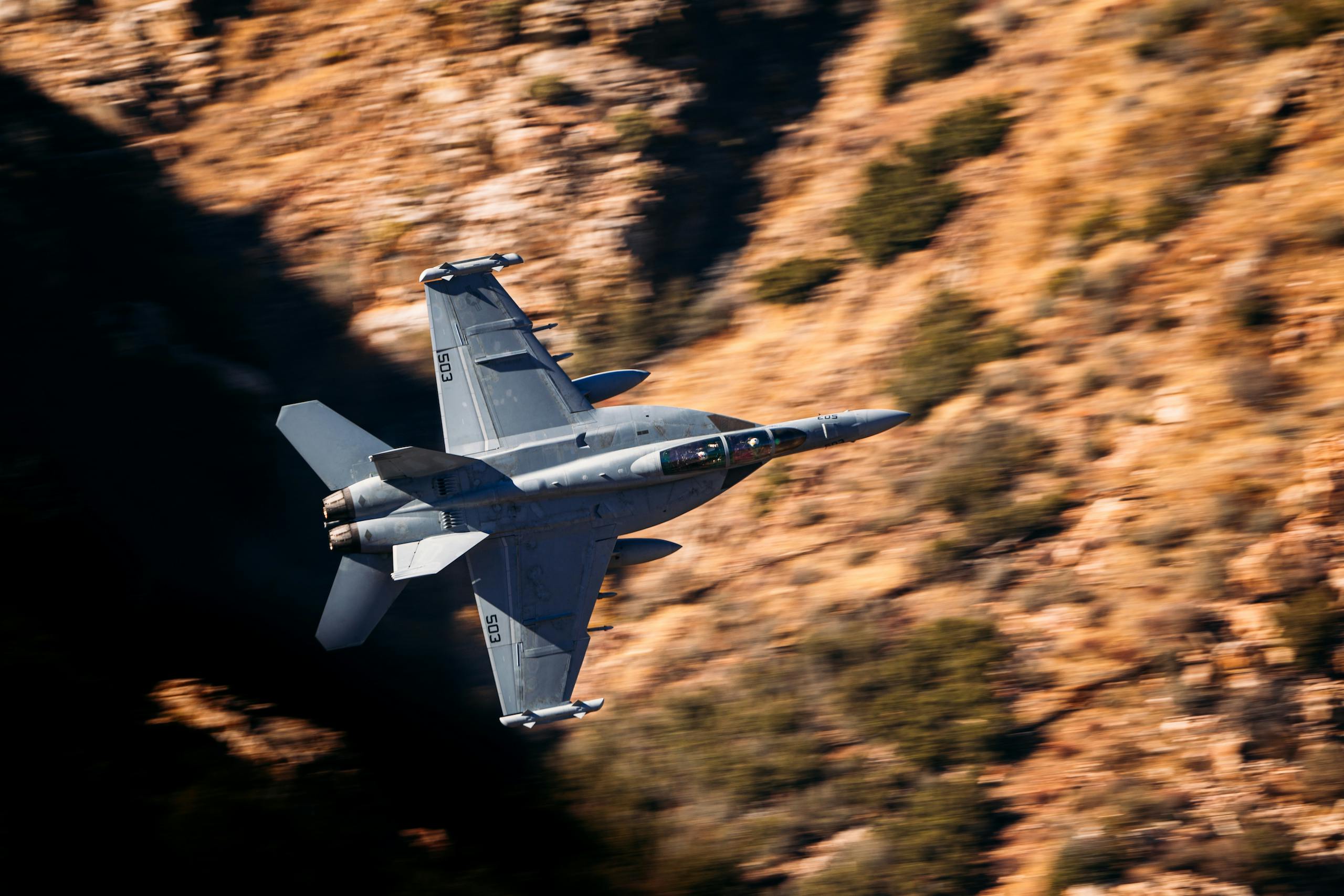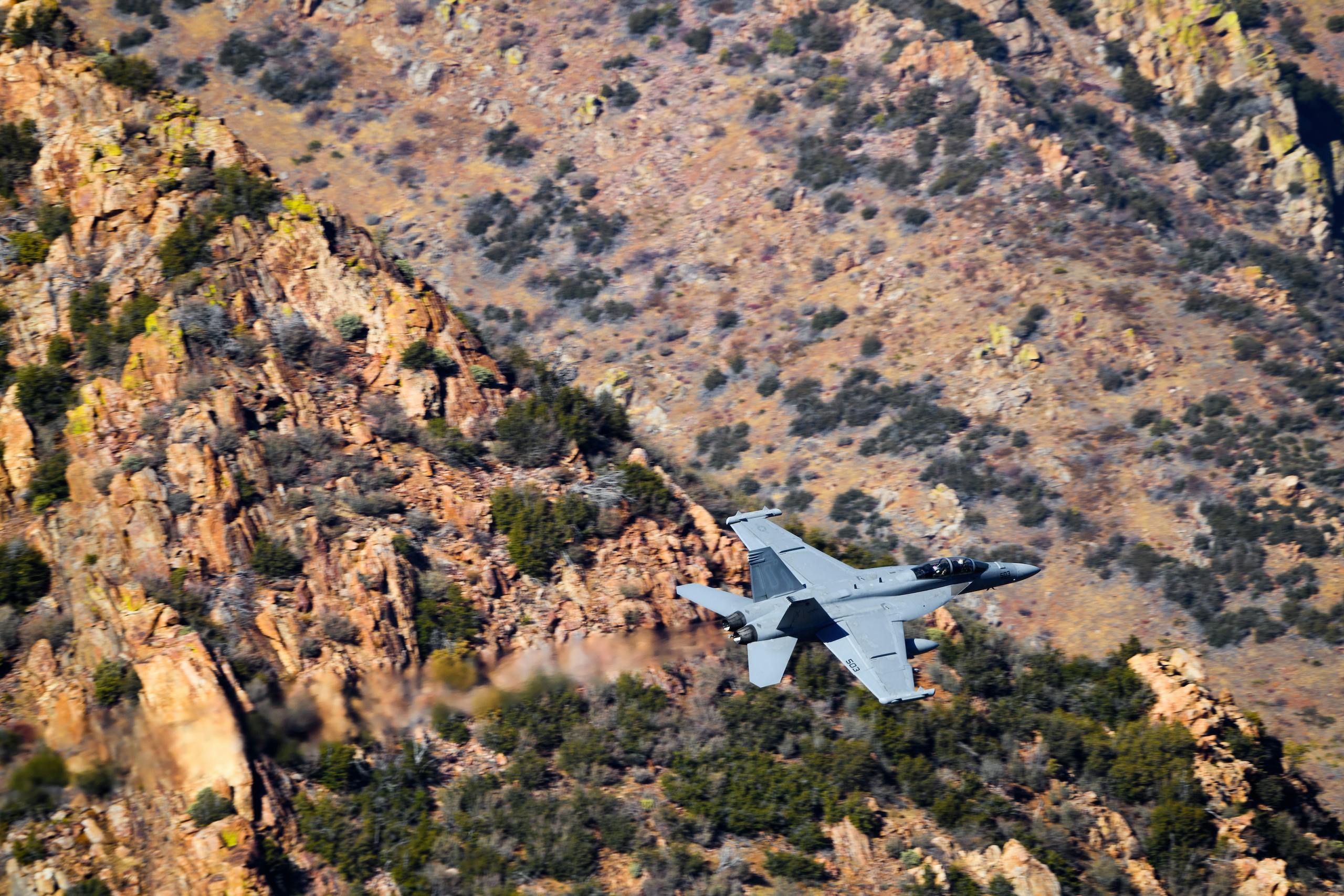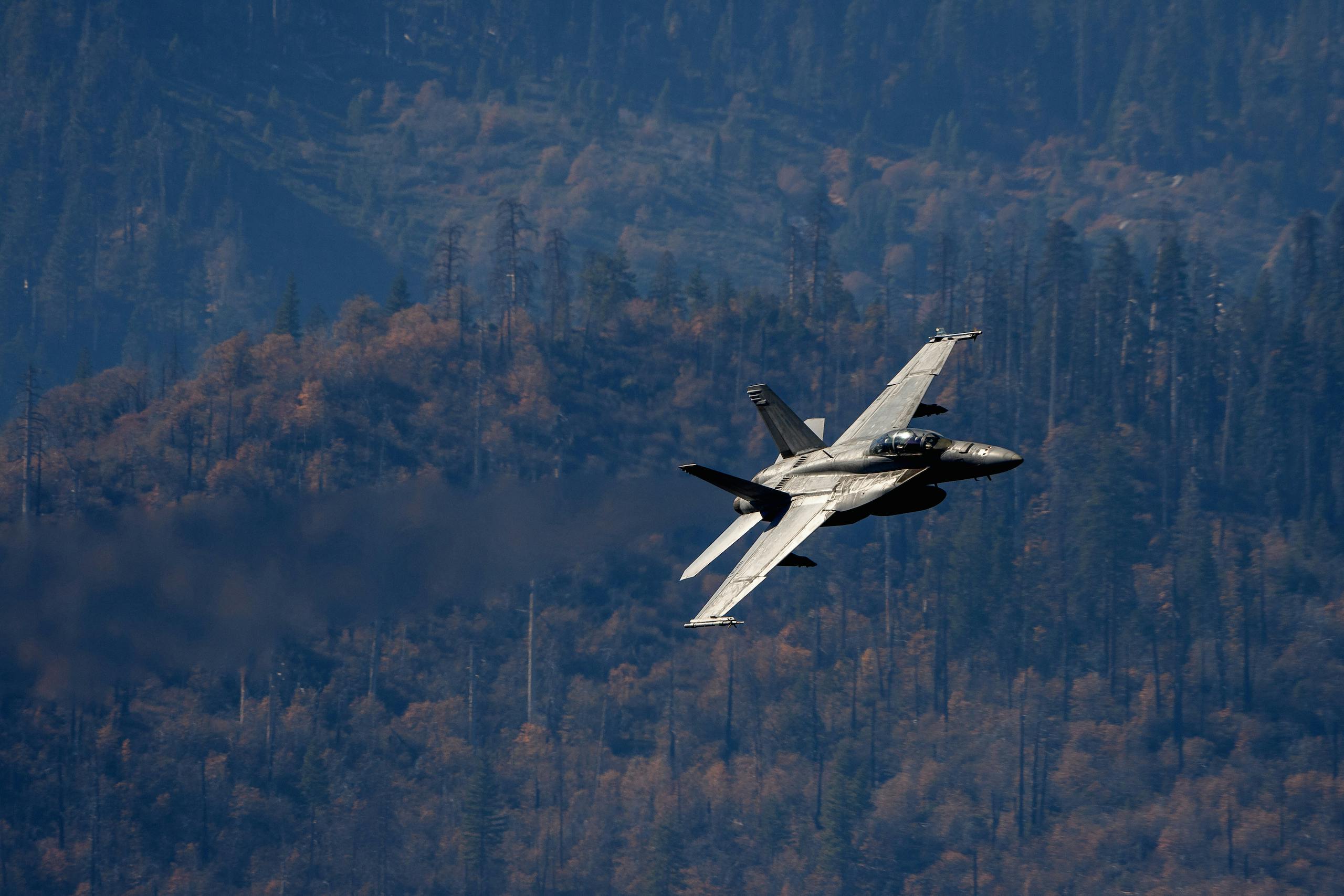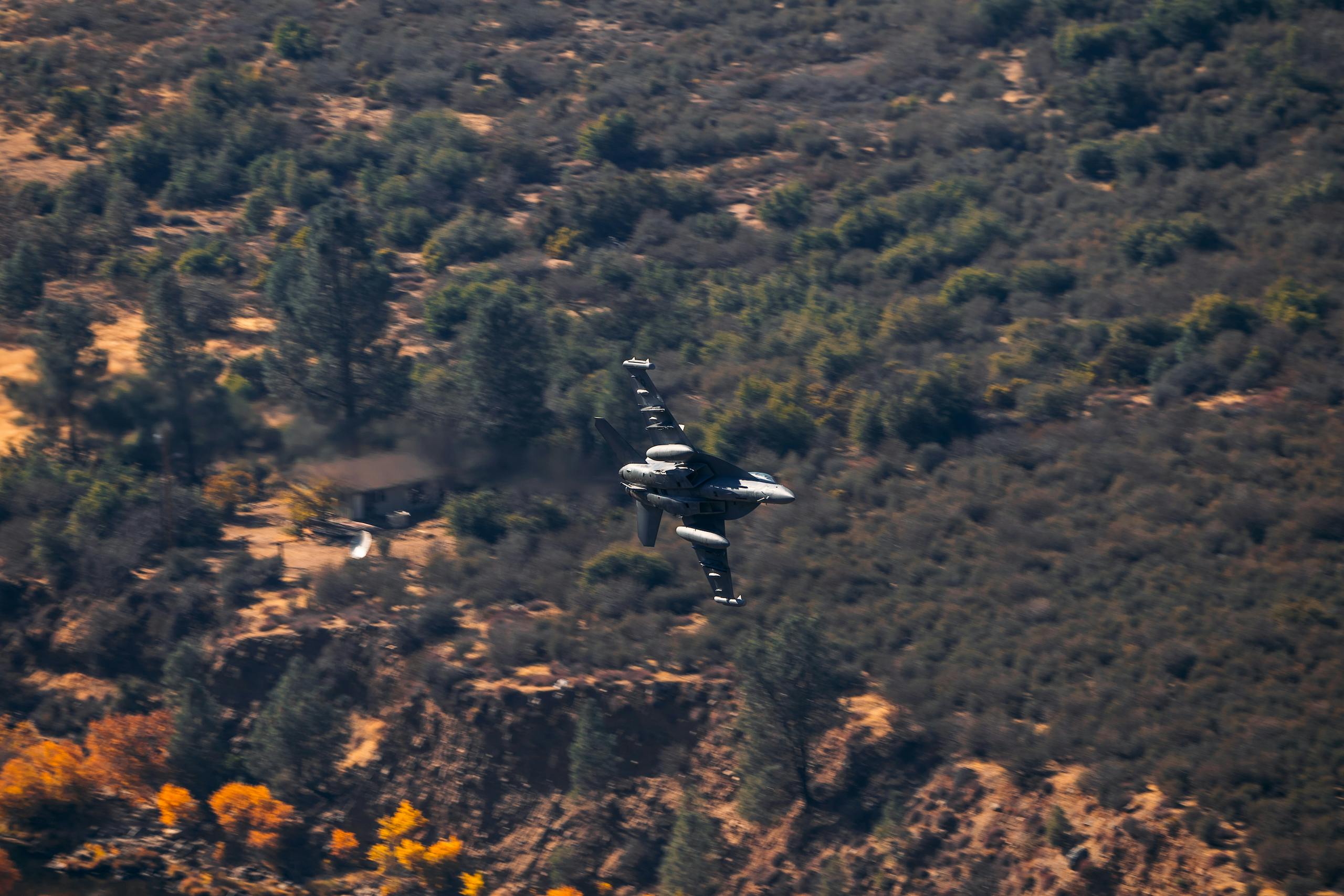Media | Articles
“An immense fault in the earth”: The hunt for jets continues
This is the second half of our Hunting Jets With Camden Thrasher feature. For a more detailed look at the Land Rover and Jeep tested on this trip, check out Sam’s reviews of the Wrangler and Defender here. Enjoy! —Ed.
Naturally, the next day, we sat on another mountain for eight hours and saw a grand total of bupkis.
We had slept the night before on a dry lake near Death Valley, a few miles from a small town. I folded the seats in the Land Rover and unrolled sleeping bag in the back. The next morning, the sun rose as it does in the desert, a blue-pink glow that crept lazily over the hills before erupting into a wash of golden light.

Shortly after dawn, Camden and I loaded our gear into a couple of backpacks and climbed a 400-foot pile of boulders at the valley’s edge. For the rest of the day, we sat around 200 feet up, waiting, with a 270-degree view of the land below. It felt like fishing, minus the smell and any kind of mucking about with hooks.
I spent the first 20 minutes on that pile getting settled. Organizing gear, poking around the boulders, arranging snacks. When I finished, I sat down on a rock the size of a Volkswagen and watched a lone cloud amble around the peak of Mt. Whitney. Down on the desert floor, on a gravel road, where humans do not regularly report their speed as a Mach number, a minivan trundled past, trailing a long cloud of dust.
Marketplace
Buy and sell classics with confidence
Nothing else happened for hours.
Not that the air was silent. Jet noise was audible all day, echoing over the horizon. Two days in, the sound felt something like a call, the heading of a Mecca to face. You could follow a rumble across the land, listen as it circled from west to east, the reverb splashing across valley. All that air rolling and tumbling. I watched heat shimmer across the lakebed and tried to picture the violence met by an air molecule in a turbine: suck toss tumble burn, then shoosh, you’re out. For almost no reason whatsoever, I also found myself thinking on mistakes, how a single poor choice can cascade into other poor choices, until you’re spit out the back of your own train of bad decisions, attempting to process what happened.
Around 11:00, two F-18s came rolling across the desert, dark and menacing, so low that they disappeared into the heat distortion rising off the sand. A moment later, each airplane flicked into a climbing roll and pitched up almost directly over my rock.
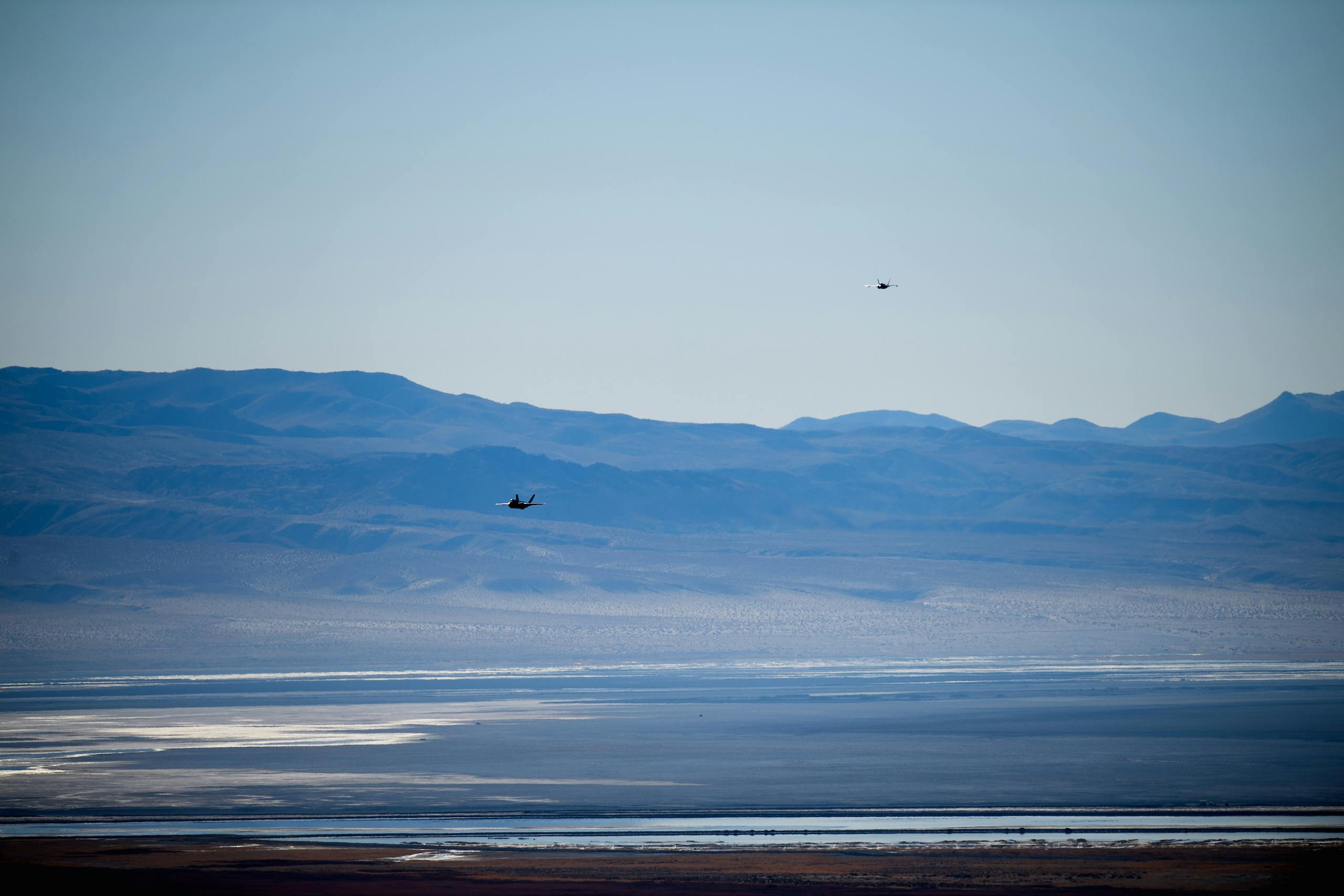
I had many thoughts about the world in that moment, and none were suited for a family website.
From a certain perspective, sitting on a pile of rocks for hours, simply for a chance to watch rare airplanes, is ridiculous. What, exactly, are you accomplishing by driving a small truck into rural America, sitting for hours or days, doing little more than collating your thoughts while eyeballing the panorama of creation?
From another perspective, what aren’t you accomplishing, doing that?

Viper 1, your bandits are set
Much of Death Valley National Park looks as you might imagine, baked and empty. Parts of the western border, however, are lush and rolling, like a lumpy comforter painted with trees. On our third day in the desert, Camden pointed us up a route in those foothills—graded gravel at first, then gnarly two-track. At one point, the Jeep’s inclinometer indicated a whopping 14 degrees of slope.
The road ended at a small plateau, a shale-covered flat surrounded by trees and gifted a virtually uninterrupted view. The rocks grabbed and tilted my boots as I walked, clinking against each other like porcelain. Below us, the land tilted and folded, losing elevation rapidly, foliage tapering as the desert rose up to eat it.
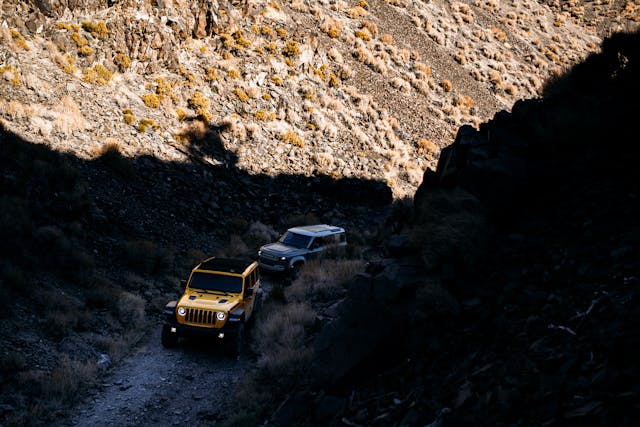
Camden set the scanner on the Jeep’s hood, then opened the Wrangler’s trunk and began rummaging through luggage. A quarter-mile away, a branch snapped audibly. The Wrangler itself was covered in silt; when Thrasher shut the rear door, the thunk of its closure dislodged a cloud of dirt that billowed over the hood, coating my face and gear. After three days without a shower, I didn’t care.
“I came up here one time before, stayed most of the day,” he said. “Saw nothing. There’s a road that leads up the hill to an old mine, though—I poked around that a bit. Google Maps says it goes a bit further.”
The scanner was a lot more active in that spot, likely because we were facing more broad and open terrain. High above, some sort of flight exercise carried on—the radio merrily burbling things like “Viper 1, your bandits are set,” and “hostiles up high, 29,000.” A small group of pilots communicated with each other, with one voice, more authoritative than the rest, choreographing and managing the whole thing.
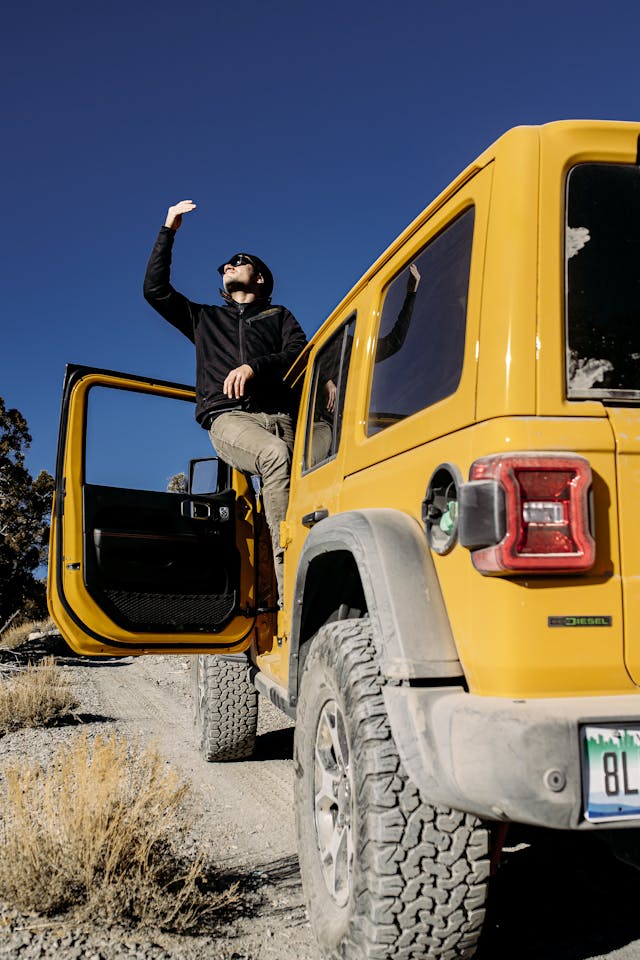
I muttered something about the strange nature of boredom, how a human can sit idle for hours in certain locations without wanting to leave but five minutes in the dentist’s chair is occasionally too much. Camden squinted at the horizon for a moment, thinking. Then he kicked a few rocks down the hill with his sneaker and proceeded to spend thirty seconds telling a story about the time he was out chasing jets and got in a fight with a squirrel.
“He made noises at me the whole day. Just, like, squeaking. Then I threw a rock at him, and he left.”
I said nothing, chewing on possibility.
“I didn’t know what his problem was,” he said. The words left his mouth in a way that both suggested genuine confusion and implied the exact opposite.
“Well,” I allowed, as deadpan as I could manage, “people say you’re good at what you do.”
An hour passed quietly, then another, and another after that. High above, two condensation plumes swept across the sky. The machines that produced them were so distant as to essentially be invisible. Camden pointed them out, then poked at an app on his phone. “Contrails—not an airliner. They’re doing something.”
“I wonder what.”
“GE has a 747 they do engine tests on. I think it has one giant engine from the triple-7? That was floating around yes—”

A wall of noise cannoned out behind us, drowning him out. Two F-22s burst from a seam in the land, a few hundred feet over our heads, then flicked down lower, batting into a shallow set of ridges. Camden, caught off guard, whirled on a toe, yanking his camera into a pan. The shutter’s motor drive chattered away, somehow audible over the blare of the jets, until just before they popped out of sight.
Movement on the ground nearby caught my eye. It looked like a shadow of an airplane but turned out to be a bird, a small jay of some sort, biting at a bit of grass. I watched it for a moment, unable to look away.
A moment of immense failure
To find the canyon at the end of the Jedi Transition, you leave the tourist burg of Lone Pine, just down the road from Mt. Whitney, and drive southeast down a two-lane highway that seems to end at the horizon. This visual trick repeats a few times, the road’s “end” being nothing more than the visible curvature of the earth, and then you are winding down a series of descending S-curves and dropping into the low and ancient graben that is Death Valley National Park.

Death Valley exists because of an immense fault in the earth. A graben is a depressed and sharply defined block of land, rarely small, born where the planet’s crust has pressed up against itself with such force as to produce a wide and relatively even change in elevation. Picture a godlike footprint the breadth of a county. In addition to being the lowest place in North America and the home of a spectacular park, the Valley has hosted military flight training since airplanes were built of doped fabric and wood. We went there the morning of the fourth day, to Rainbow Canyon, simply to see the place.
Military aircraft no longer fly through Rainbow Canyon because Rainbow once held a fireball. The idea can be difficult to wrap your head around in the abstract, and it’s even more difficult to process when you’re standing mere feet from literal scorched earth. Humanity has spent much time and effort shaping inherently dangerous practices so as to eliminate or drastically reduce the chance of a tornado of blooming flame. You have to work real hard these days to make fire happen inside a race car, and the phenomenon is now so rare in civil aviation as to make motor racing look positively foolhardy.
The limits of our striving grow safer every year, and for good reason. Which is why the shock of our intense failure can be so … shocking, so intense.

The canyon itself is bigger than it looks, a V-shaped gutter in the land that ends suddenly, its end a maw aiming into the valley below. The internet is littered with first-person accounts of plane-watching here, blogs and posts from ordinary people who rose before dawn and drove for hours simply to secure a parking space and a seat. Before the crash, an aviation journalist dubbed the place a “Mt. Everest and the Louvre” of plane-spotting, a hotbed of “white-scarf, stick-and-rudder flying skills.” There was, he said, nowhere like it in the world, and you cannot stand there and imagine the flying while doubting that claim.
I leaned over the railing and looked into the chasm below. It seemed too shallow and narrow to hold anything like a jet. Camden was quieter than usual.
“Sometimes they’d run it backward,” he said, softly. “You could stand on that ridge”—he pointed to the left—“and watch them come straight at you. There were so many ways and places to shoot it in one place, you were so close …”
Forty feet away, in a nearly empty parking lot, a middle-age woman in a Chrysler Pacifica sat talking on the phone.
Eight-figure hardware and human accomplishment, in your face and spectacular. Gone now and unlikely to come back, like how we used to run the Indy 500 without catch fencing or let F1 photographers stand inches from passing cars. The F-18 accident here came toward the end of the route, on the canyon’s southern wall, the scorch mark 40 feet below what the National Park Service calls the Father Crowley Scenic Overlook. There is a pit toilet at the end of the lot, a few feet away, and several places where a person without much sense of risk could simply walk along the unguarded canyon edge.

According to a Navy investigation, the pilot, 33-year-old Lieutenant Charles Walker, descended through 4000 feet in full afterburner. Then he simply made a mistake.
“You need to be very cautious of your own biases,” the F-35 test pilot had told me. Most of our 20-minute conversation had orbited thought process and risk. “Your own susceptibility. Realizing that you could be disoriented. What kills most pilots [who die in the airplane] is unrecognized spatial disorientation. They just don’t realize it.”

The art of being aware, without thinking too hard about the act of being aware, because too much of that kind of thinking could pull focus from the task at hand and very much possibly bring an abrupt and permanent end to any kind of awareness whatsoever.
One hundred feet off the deck, I asked—is it uncomfortable?
“Very unnerving,” he said. “You just can’t afford to screw up at all—you need to realize you’re literally a tenth of a second away from killing yourself, at any moment, right? And you can’t just trust your eyes. What looks like a tree at 600 mph could actually be a bush. If you think it’s a tree, but it’s a bush, you’re … way too close, if that makes any sense.”
He used the words “wary” and “respect” a lot.
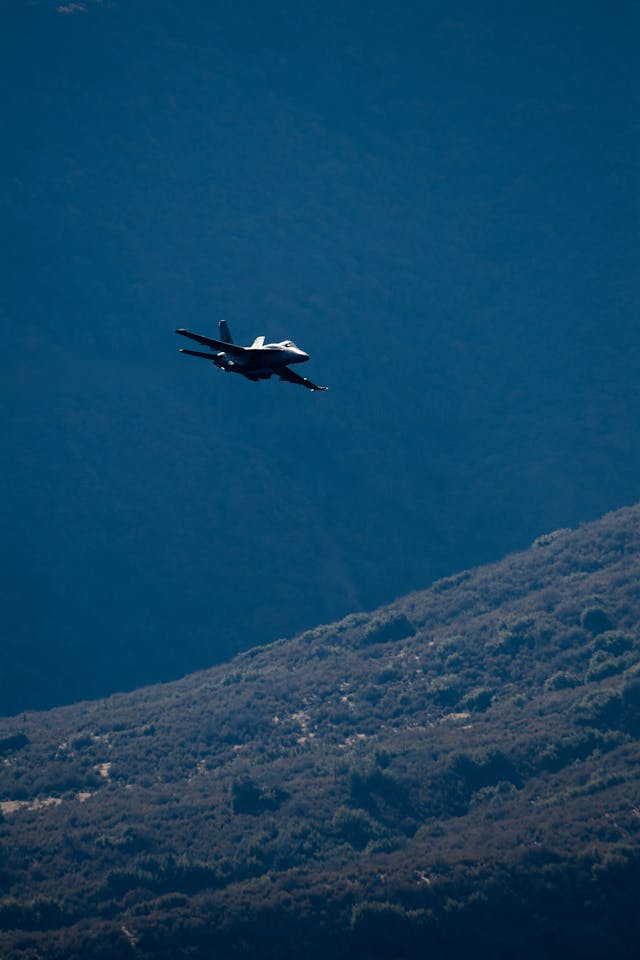
Some things are simply a certain baseline of appealing, no matter what we have to do to chase them, and the work to get there is often half the draw. The definitions and justification vary with personality, but an inarguable truth remains: If you have the chance to witness something remarkable, then you know what it was like to be there, in that moment, on that day. Which is more than you knew before.
I turned to Camden. Was it better to come here, I asked, when the canyon was jumping, airplanes every few minutes, or would you rather spend hours sitting in the woods, waiting, as we had for most of the week, with all the detective work and hope?
On the hood of the Jeep, the scanner squawked one more time: “Two F-15s over dry lake, off Jedi Transition, proceeding north.”
Camden thought for a moment. He shrugged, eyes hidden behind sunglasses, in a way that did not suggest an answer. One hand went to a pocket as the other picked up the camera. Then he turned once more, looking and listening, back to the sky.
**
Sam Smith is an editor-at-large with Hagerty. He came to the company after an eight-year stint at Road & Track, where he served as both executive editor and editor-at-large. He lives in Tennessee with a very rusty BMW 2002, a small collection of motorcycles, and a very patient wife.
Follow him on Instagram and Twitter: @thatsamsmith
